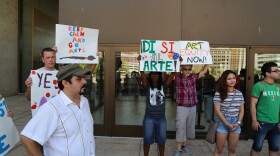The annual fight to wrangle a working city budget in Dallas is over. The . Throughout the process, arts groups serving African-American and Latino audiences argued and protested for more funding.
Art&Seek’s Hady Mawajdeh reports on why these groups are fighting for what’s known as cultural equity.
The fight began with what protesters called a for one of the city’s largest arts organizations – the AT&T Performing Arts Center. When opponents found out the Center needed , they were not happy. Leaders from small and medium-sized arts groups began mobilizing opposition. They even .
According to the president and CEO of the Performing Arts Center, the Center was $151 million in debt. But they recently paid about a third of the debt — making the most recent balance $95 million. The debtors, Bank of American and J.P. Morgan Chase have agreed to forgive another third. And the Center is confident it can raise $35 million from donors. Here's where the city funds come into play: the Center needs the city of Dallas to pitch in the last 10 percent.
Small arts groups that serve African-American, Latinos and other minority audiences say that doing so is unfair. , says "If I mismanage my budget then basically we don’t exist anymore. We don’t get a bailout."
Despite efforts to stop the city from helping AT&T PAC with its debt the council passed the budget and the Center will get its $15 million spread out over the next decade.
What is cultural equity?
It means that all people, especially those who have been historically underrepresented based on race, ethnicity or gender, are represented in the arts.
Now, this doesn’t just mean showing a painting by an artist of color or performing a play from a minority playwright from time to time. It means bringing people of color into boardrooms and curatorial roles. It means thinking about audiences of color and it means funding artists.
Full story: .
On Think: at noon on Monday, Sept. 26.




